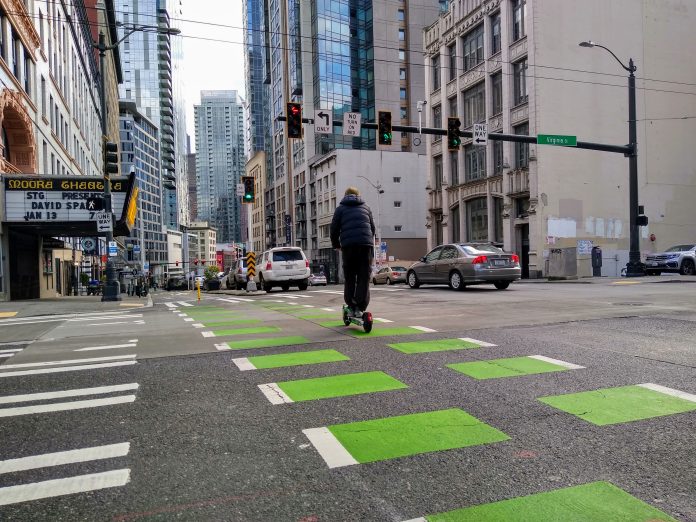On Thursday, the Puget Sound Regional Council’s (PSRC) Transportation Policy Board approved a new framework for allocating an anticipated $580 million dollars in federal transportation funding from the Federal Highway Administration (FHWA) and the Federal Transit Administration (FTA). The funds won’t be available until 2025 and 2026, but the policy was adopted in advance of a call for projects from across the region being issued next month, with a full list of projects expected to be approved by this fall.
Project evaluation criteria changes like this often slip by without much attention, but ultimately the adjustment will have a substantial impact on which projects get funding this cycle and will likely set a precedent for future cycles: PSRC allocates federal funding like this every two years. You can see a full list of the projects awarded funding in 2020 here. Generally the framework only gets tweaked every few years, but this cycle included a project selection task force that met over eight months to come to a consensus around changes. That task force was made up of over 40 elected officials and stakeholders from around the region, around 30 of whom were able to vote on proposed changes.
PSRC has long established “set-asides” for the funds from the Federal Highway Administration, which are generally able to be spent on the broadest set of uses. Out of an expected $179 million, 10% will go toward town centers and corridor projects located in rural areas, something that wasn’t changed with the adjustments approved Thursday. 20% will go toward preservation of existing infrastructure. And a long-established set-aside for bicycle and pedestrian focused projects will stay at 10%. There was a desire among members of the project selection taskforce to increase that amount to 15%, and last July the group actually voted to adopt the change. Yet the increase didn’t make it into the final proposal adopted this week for reasons that remain unclear.
Vicky Clarke, Policy Director at Cascade Bicycle Club, raised concerns to the board about the process around that bicycle and pedestrian set-aside. “This body is well versed in the data that shows serious injuries and crashes for vulnerable road users are increasing not decreasing. Investing in safety is investing in dedicated spaces for people walking, biking, and rolling — that’s why the set-aside matters. And that’s why we are particularly disappointed that despite the task force making the recommendation to increase the set-aside from 10% — where it has been for a decade — to 15%, this change is not reflected in the recommendations moving forward today,” she said.
Anna Zivarts, director of the Disability Mobility Initative at Disability Rights Washington, echoed the call for more spending on pedestrian access. “As we’ve heard from the nearly 200 non-drivers we’ve interviewed from throughout the state, we desperately need a connected and accessible sidewalk network, and to start to think seriously about how people connect to transit…we also would have loved to see some discussion of a dedicated set-aside for ADA transition plans,” she said.
Some board members expressed a desire to increase funding for bicycle and pedestrian focused projects, but none were willing to propose a last-minute change that would have meant more funding would be earmarked for them. “I would have supported an additional set-aside for bike/ped, I think we missed a bit of an opportunity there,” Tacoma Councilmember Kristina Walker said. Other members, notably Poulsblo Mayor Becky Erikson, defended the status quo by pointing to pedestrian- and bicycle-oriented elements of other projects that may themselves not have been direct bike and pedestrian projects. But adding a sidewalk or a federally-required curb ramp to a roadway expansion project doesn’t make it a pedestrian project.
What was included in the final proposal was a new 5% set-aside for equity-focused projects, which will be allocated through a separate process later this year via PSRC’s new Equity Advisory Group. That group will evaluate the broader funding approval process on the basis of equity and make recommendations on improving outcomes in that area.
The changes approved also overhaul the points system that every project is graded on, with equity added as a new category for a project to be awarded points on, and safety and security, which had been embedded in previous criteria, now as an additional stand-alone category. This should result in projects that address safety and improve equity being prioritized more than they have in the past.
That updated safety criteria even includes elements such as how focused the project is on improving safety for people walking, rolling, and biking, and whether the project will lead to a reduced reliance on enforcement.
It’s likely that the federal infrastructure bill signed into law this past November could mean even more federal funds come through the Puget Sound Regional Council; right now it’s too early to say how much funding that could be. But this process will likely form a precedent for additional dollars coming in the future. While advocates were disappointed to not see that set-aside for bicycle and pedestrian projects increased, the new project selection criteria should represent a big improvement over what had been done before and make a real difference in terms of providing funds for urgently needed transportation improvements across the region.
Ryan Packer has been writing for The Urbanist since 2015, and currently reports full-time as Contributing Editor. Their beats are transportation, land use, public space, traffic safety, and obscure community meetings. Packer has also reported for other regional outlets including BikePortland, Seattle Met, and PubliCola. They live in the Capitol Hill neighborhood of Seattle.


